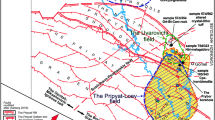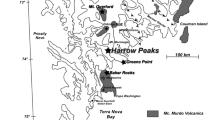Abstract
Interstitial to poikilitic amphibole found in garnet pyroxenite xenoliths has been interpreted, in the past, to represent a critically silica undersaturated, residual intercumulus melt trapped by its cumulate assemblage of anhydrous phases. The textural features of such amphibole in pyroxenite xenoliths from Nunivak Island, Alaska, however, are more compatible with an origin by replacement of the anhydrous phases of the pyroxenite, following a period of cooling and sub-solidus recrystallization in the upper mantle. The reaction of amphibole and olivine to give orthopyroxene, observed in two specimens, requires that the associated fluid phase was not critically silica undersaturated. The amphibole is therefore thought to reflect the interaction of an alkali-bearing, migratory, aqueous fluid and an upper mantle consisting of spinel lherzolite cut by veins of spinel and garnet pyroxenite.
Similar content being viewed by others
References
Albee, A.L., Ray, L.: Correction factors for electron probe microanalysis of silicates, oxides, carbonates, phosphates and sulphates. Anal. Chem. 42, 1408–1414 (1970)
Beeson, M.H., Jackson, E.D.: Origin of the garnet pyroxenite xenoliths at Salt Lake Crater, Oahu. Mineral. Soc. Am. Spec. Pap. 3, 95–112 (1970)
Best, M.G.: Amphibole-bearing cumulate inclusions, Grand Canyon, Arizona and their bearing on silica-undersaturated hydrous magmas in the upper mantle. J. Petrol. 16, 212–236 (1974)
Best, M.G.: Kaersutite-Peridotite inclusions and kindred megacrysts in basanitic lavas, Grand Canyon, Arizona. Contrib. Mineral. Petrol. 27, 25–44 (1970)
Chapman, N.A.: An experimental study of spinel clinopyroxenite xenoliths from the Duncansby Ness Vent, Caithness, Scotland. Contrib. Mineral. Petrol. 51, 223–230 (1975)
Conquéré, F.: Les pyroxénolites à amphibole et les amphibololites associées aux lherzolites du gisement de lherz (Ariège, France): Un example du rôle de l'eau au cours de la cristallisation fractionée des liquides issus de la fusion partielle de lherzolites. Contrib. Mineral. Petrol. 33, 32–61 (1971)
Dickey, J.S.: Partial fusion products in alpine-type peridotites: Serrania de la ronda and other examples. Mineral. Soc. Am. Spec. Pap. 3, 33–49 (1970)
Dickey, J.S.: Eclogitic and other inclusions in the mineral breccia member of the deborah volcanic formation at Kakanui, New Zealand. Am. Mineralogist 53, 1304–1319 (1968)
Eggler, D.H.: Effect of CO2 on the melting of peridotite. Annual Report 1973–74, Geophysical Laboratory, 215–224 (1974)
Finger, L.W., Hadidiacos, C.G.: Electron microprobe automation. Carnegie Inst. Wash. Yearb. 71, 578–600 (1972)
Francis, D.M.: The origin of amphibole in lherzolite xenoliths from Nunivak Island, Alaska. J. Petrol., in press (1976)
Green, D.H.: The origin of the eclogites from Salt Lake Crater, Hawaii. Earth. Planet. Sci. Lett. 1, 414–420 (1966)
Hoare, J.M., Condon, W.H., Cox, A., Dalrymple, G.B.: Geology, paleomagnetism and potassiumargon ages of basalts from Nunivak Island, Alaska. Geol. Soc. Am. Mem. 116, 377–412 (1968)
Irving, A.J.: Geochemical and high pressure experimental studies of garnet pyroxenite and pyroxene granulite xenoliths from the Delegate Basaltic Pipes, Australia. J. Petrol. 15, No. 1, 1–40 (1974)
Kornprobst, J.: Les peridotites et les pyroxénolites du Massif Ultrabasique des Beni Bouchera: Une etude expérimentale entre 1100 et 1 550 ° C, sous 15 à 30 kilobars de pression sèche. Contrib. Mineral. Petrol. 29, 290–309 (1970)
Kornprobst, J.: Les Massif Ultrabasique des Beni Bouchera (Rif Interne, Maroc): Etude des péridotites de haute température et de haute pression, et des pyroxénolites, à grenat ou sans grenat, qui leur sont associées. Contrib. Mineral. Petrol. 23, 283–322 (1969)
Kronprobst, J., Conquéré, F.: Les pyroxenolites à grenat du Massif de Lherzolite de Moncaup (Haute Garonne-France); Caracteres communs avec certaines enclaves des basaltes alcalins. Earth Planet. Sci. Lett. 16, 1–14 (1972)
Kushiro, I.: The system forsterite-anorthite-albite-silica-H2O at 15 kb. and the genesis of andesitic magmas in the upper mantle. Annual Report 1973–74, Geophysical Laboratory, 244–248 (1974)
Kushiro, I.: Effect of water on the composition of magmas formed at high pressures. J. Petrol. 13, 311–334 (1972)
Lovering, J.F., White, A.J.R.: Granulitic and eclogitic inclusions from basic pipes at Delegate, Australia. Contrib. Mineral. Petrol. 21, 9–52 (1969)
Mason, B.: Eclogitic xenoliths from volcanic Breccia at Kakanui, New Zealand. Contrib. Mineral. Petrol. 19, 316–327 (1968)
Mercier, J.C.C., Nicolas, A.: Textures and fabrics of upper mantle peridotites as illustrated by xenoliths from basalts. J. Petrol. 16, No. 2, 454–487 (1975)
Mysen, B.O., Boettcher, A.L.: Melting of a hydrous mantle: I. Phase relations of natural peridotite at high pressures and temperatures with controlled activities of water, carbon dioxide, and hydrogen. J. Petrol. 16, No. 3, 520–548 (1975)
Mysen, B.O., Boettcher, A.L.: Melting of a hydrous mantle: II. Geochemistry of crystals and liquids formed by anatexis of mantle peridotite at high pressures and temperatures as a function of controlled activities of water, hydrogen, and carbon dioxide. J. Petrol. 16, No. 3, 549–593 (1975)
Mysen, B.O., Kushiro, I., Nicholls, I.A., Ringwood, A.E.: A possible mantle origin for andesite magmas: Discussion of a paper by Nicholls and Ringwood. Earth. Planet. Sci. Lett. 12, 221–229 (1974)
Nicholls, I.A., Ringwood, A.E.: Effect of water on olivine stability in tholeiites and the production of silica-saturated tholeiitic magmas in the Island-Arc Environment. J. Geol. 81, 285–300 (1973)
Shervais, J.W., Wilshire, H.G., Schwarzman, E.C.: Garnet clinopyroxenite xenolith from Dish Hill, California. Earth Planet. Sci. Lett. 19, 120–130 (1973)
White, A.J.R.: Coexisting clinopyroxene, garnet and amphibole from an “eclogite”, Kakanui, New Zealand. Contrib. Mineral. Petrol. 34, 185–191 (1972)
Wilkinson, J.F.G.: Garnet clinopyroxenite inclusions from diatremes in the Gloucester Area, New South Wales, Australia. Contrib. Mineral. Petrol. 46, 275–299 (1974)
Author information
Authors and Affiliations
Rights and permissions
About this article
Cite this article
Francis, D.M. Amphibole pyroxenite xenoliths: Cumulate or replacement phenomena from the upper mantle, Nunivak Island, Alaska. Contr. Mineral. and Petrol. 58, 51–61 (1976). https://doi.org/10.1007/BF00384744
Received:
Accepted:
Issue Date:
DOI: https://doi.org/10.1007/BF00384744




